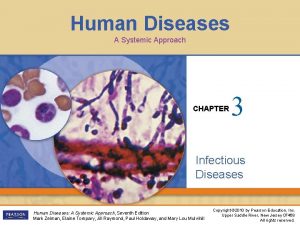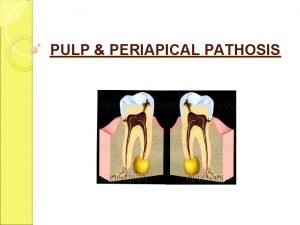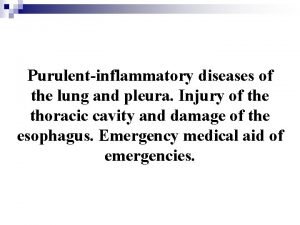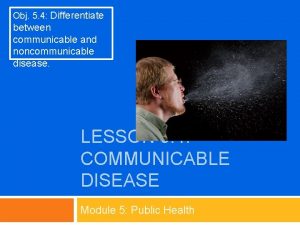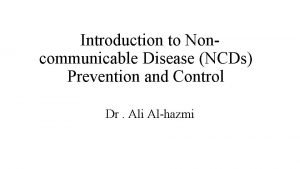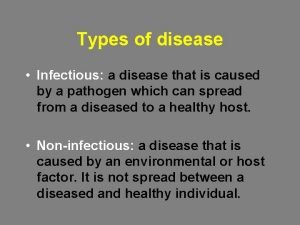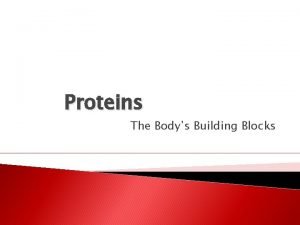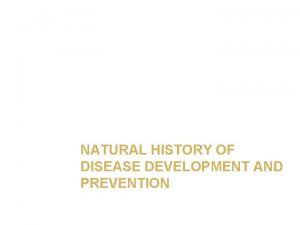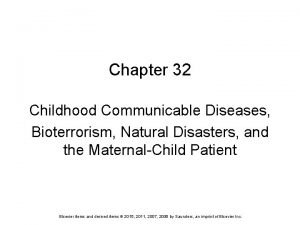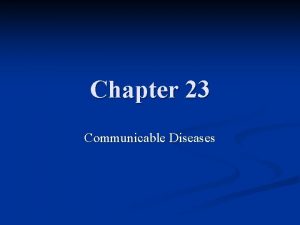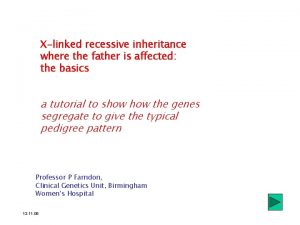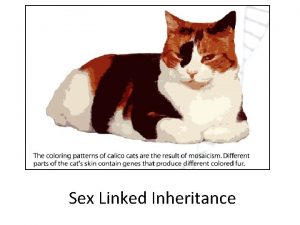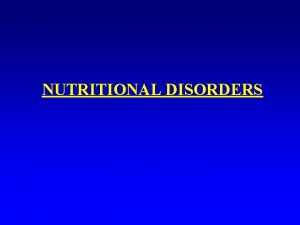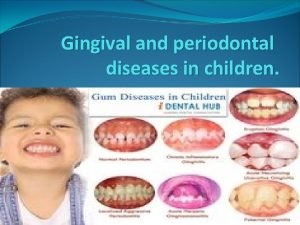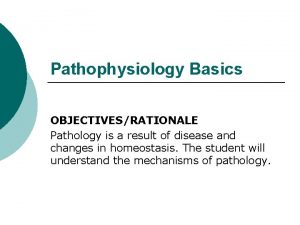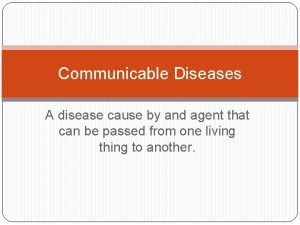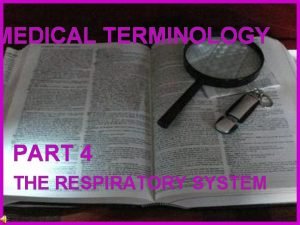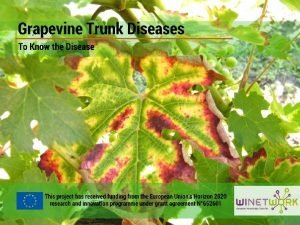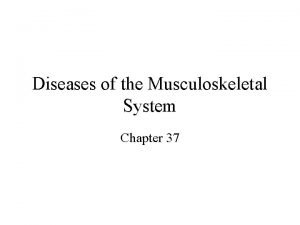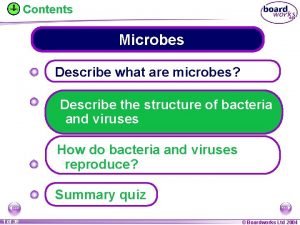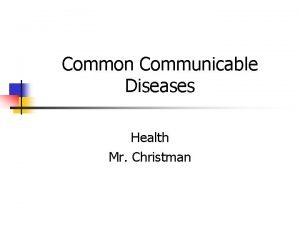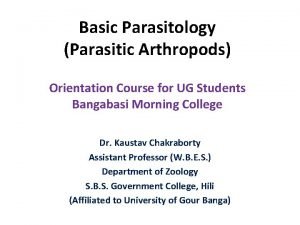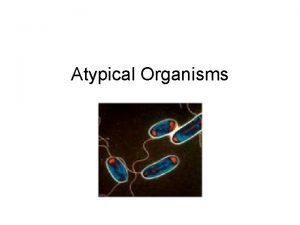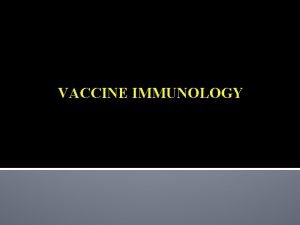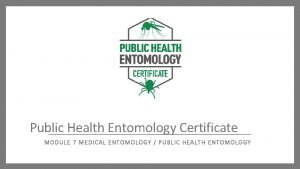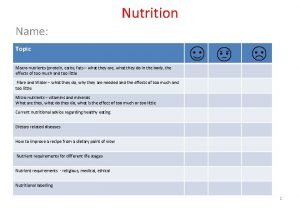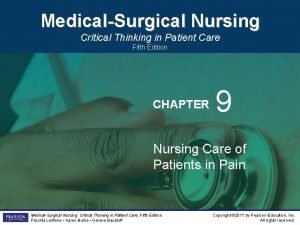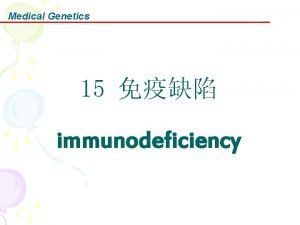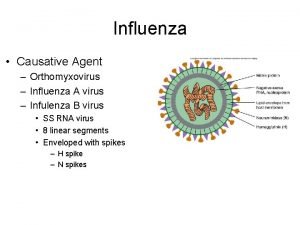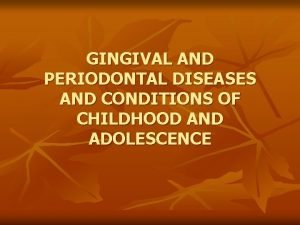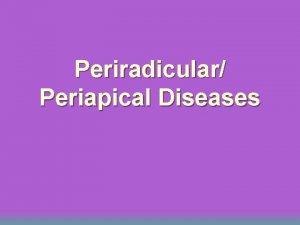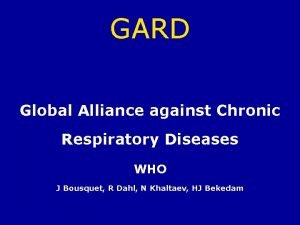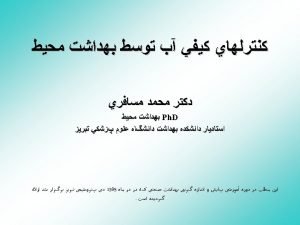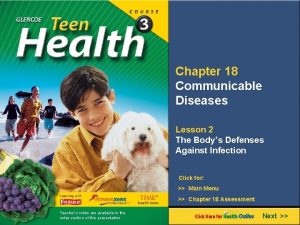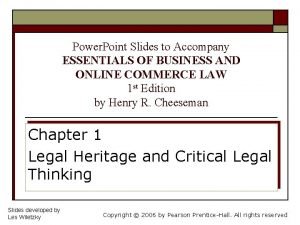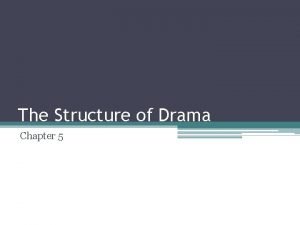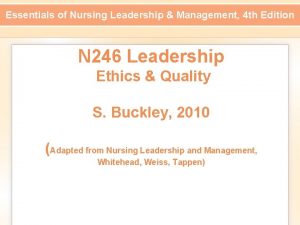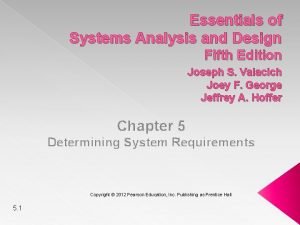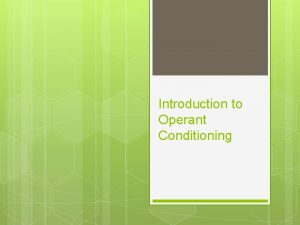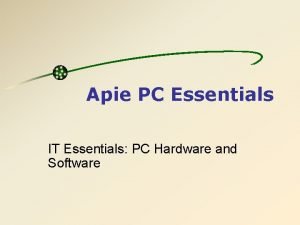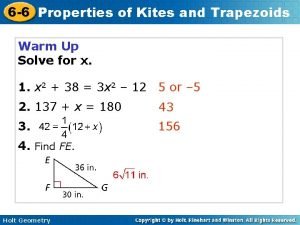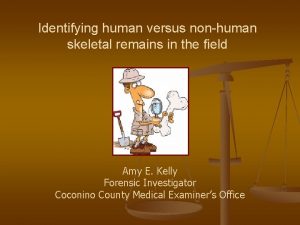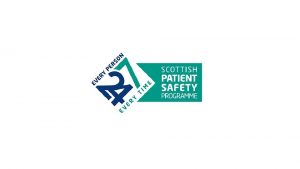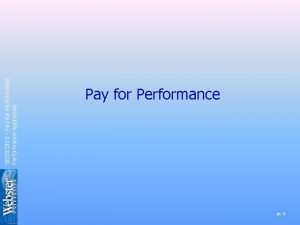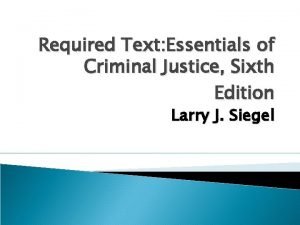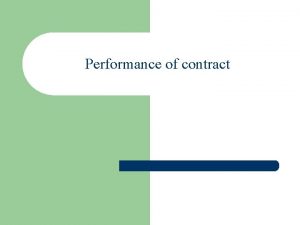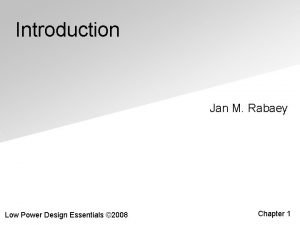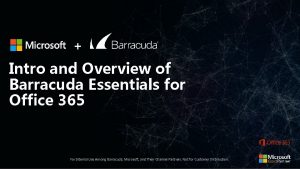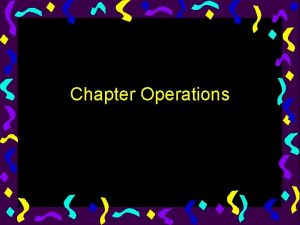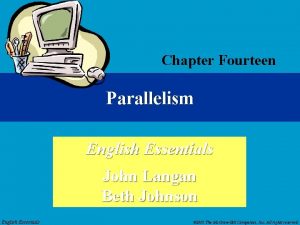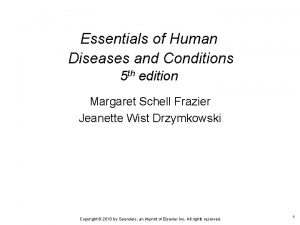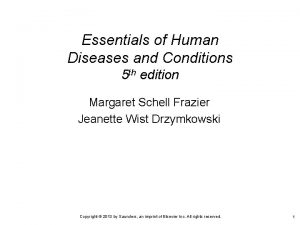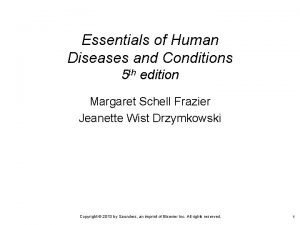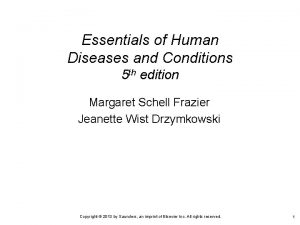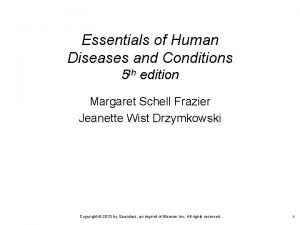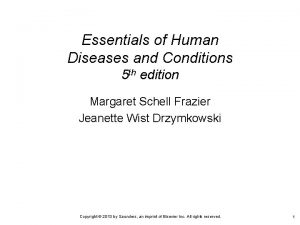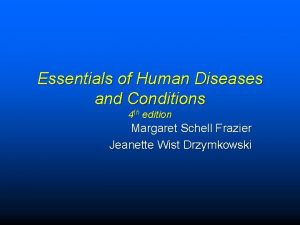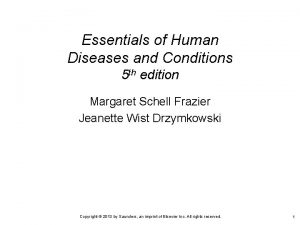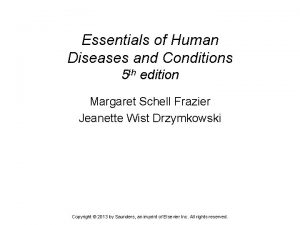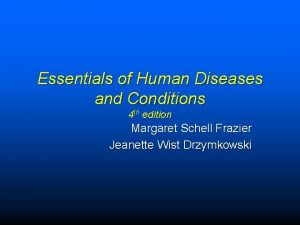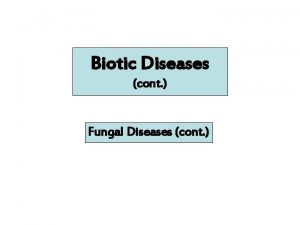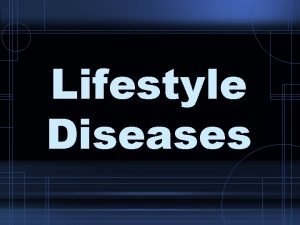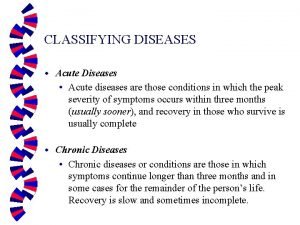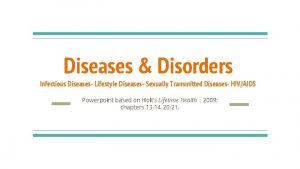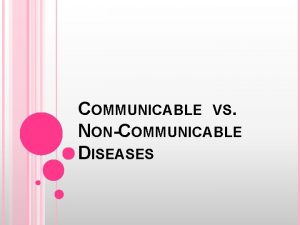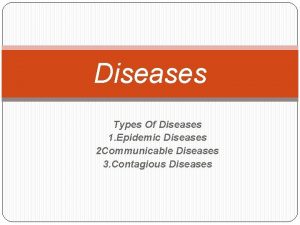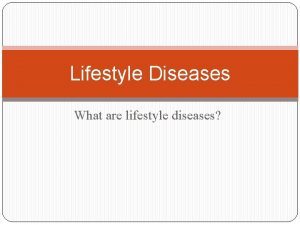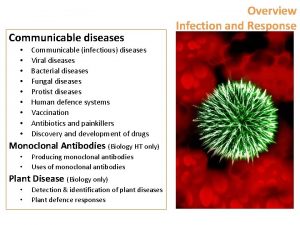Essentials of Human Diseases and Conditions 5 th



















































































































- Slides: 115

Essentials of Human Diseases and Conditions 5 th edition Margaret Schell Frazier Jeanette Wist Drzymkowski Copyright © 2013 by Saunders, an imprint of Elsevier Inc. All rights reserved. 1

Chapter 13 Neurologic Diseases and Conditions Copyright © 2013 by Saunders, an imprint of Elsevier Inc. All rights reserved. 2

Lesson 13. 1 Vascular Disorders, Head Trauma, and Spinal Cord Injuries 1. Name the main components of the nervous system. 2. List some of the problems to which the nervous system is susceptible. 3. Describe how data are collected during a neurologic assessment. 4. Name the common symptoms and signs of a cerebrovascular accident (CVA). Copyright © 2013 by Saunders, an imprint of Elsevier Inc. All rights reserved. 3

Lesson 13. 1 Vascular Disorders, Head Trauma, and Spinal Cord Injuries (Cont’d. ) 5. Name three vascular disorders that may cause a CVA. 6. Define a transient ischemic attack (TIA). 7. Distinguish between (a) epidural and subdural hematomas and (b) cerebral concussion and cerebral contusion. 8. Describe three mechanisms of spinal injuries. 9. Name the goals of treatment of spinal cord injuries. Copyright © 2013 by Saunders, an imprint of Elsevier Inc. All rights reserved. 4

Orderly Function of the Nervous System The nervous system is a complex network comprised of: Neurons (nerve cells that make up the brain) Ø Spinal cord Ø Nerves Ø Copyright © 2013 by Saunders, an imprint of Elsevier Inc. All rights reserved. 5

Orderly Function of the Nervous System (Cont’d. ) The nervous system is composed of two divisions: Central nervous system (brain and spinal cord) Ø Peripheral nervous system (nerves that radiate from the spinal cord throughout the body) Ø Copyright © 2013 by Saunders, an imprint of Elsevier Inc. All rights reserved. 6

Orderly Function of the Nervous System (Cont’d. ) The peripheral nervous system is divided into two parts: Sympathetic Ø Parasympathetic • Together, these regulate the voluntary (muscle movements) and involuntary (heart rate) functions of the body Ø Copyright © 2013 by Saunders, an imprint of Elsevier Inc. All rights reserved. 7

The Peripheral Nervous System Copyright © 2013 by Saunders, an imprint of Elsevier Inc. All rights reserved. 8

Orderly Function of the Nervous System (Cont’d. ) The nervous system is susceptible to various problems: Ø Vascular compromise and circulatory deficits Ø Injury Ø Infection Ø Inherited defect Ø Congenital defect Ø Degeneration Ø Tumor Copyright © 2013 by Saunders, an imprint of Elsevier Inc. All rights reserved. 9

Neurologic Assessment There a variety of methods to evaluate neurologic status and cognitive function: Ø Take thorough medical history, including any medications Ø Test mental functions (speech, language, and writing skills) Ø Test cranial nerve function (sense of smell, vision, taste, hearing, swallowing, etc. ) Ø Test motor function (muscle strength and tone) Ø Test coordination and balance Ø Test sensory function (diminished or abnormal sensation) Copyright © 2013 by Saunders, an imprint of Elsevier Inc. All rights reserved. 10

Cerebrovascular Accident (Stroke) Occurs when the brain is damaged by a sudden disruption in the flow of blood to a part of the brain or by bleeding inside the head Copyright © 2013 by Saunders, an imprint of Elsevier Inc. All rights reserved. 11

Cerebrovascular Accident (Stroke) (Cont’d. ) Copyright © 2013 by Saunders, an imprint of Elsevier Inc. All rights reserved. 12

Cerebrovascular Accident (Stroke) (Cont’d. ) Common symptoms include sudden: Severe headache Ø Partial or total loss of the ability to articulate ideas or comprehend spoken or written language (aphasia) Ø Weakness (hemiparesis), numbness, or paralysis (hemiplegia), confusion, or impaired consciousness Ø Loss or blurring of vision, double vision (diplopia) Ø Dizziness, loss of balance or coordination Ø Copyright © 2013 by Saunders, an imprint of Elsevier Inc. All rights reserved. 13

Cerebrovascular Accident (Stroke) (Cont’d. ) Causes Ø A CVA is usually a result of one of three types of vascular disorders: • Blood clot (cerebral thrombosis) • Cerebral hemorrhage • Cerebral embolism • Artery blockage (atherosclerosis) or hypertension (high blood pressure) Copyright © 2013 by Saunders, an imprint of Elsevier Inc. All rights reserved. 14

Cerebrovascular Accident (Stroke) (Cont’d. ) Treatment Immediate medical intervention within 3 hours of stroke may limit brain damage Ø Includes • Immediately chewing an aspirin • Anticoagulants (to prevent clotting of blood) • Surgery to improve circulation and remove clots Ø Copyright © 2013 by Saunders, an imprint of Elsevier Inc. All rights reserved. 15

Cerebrovascular Accident (Stroke) (Cont’d. ) Prevention Ø Known risk factors include: • Smoking • Excesses in diet and alcohol consumption • High blood pressure • Diabetes Copyright © 2013 by Saunders, an imprint of Elsevier Inc. All rights reserved. 16

Transient Ischemic Attack Temporary episode of impaired neurologic functioning caused by an inadequate flow of blood to a portion of the brain Copyright © 2013 by Saunders, an imprint of Elsevier Inc. All rights reserved. 17

Transient Ischemic Attack (cont'd. ) Symptoms Sudden weakness or numbness down one side of body (hemiparesis) Ø Dizziness Ø Dysphagia Ø Confusion Ø Copyright © 2013 by Saunders, an imprint of Elsevier Inc. All rights reserved. 18

Transient Ischemic Attack (Cont’d. ) Diagnosis History and physical examination Ø Cranial MRI scan Ø CT scan Ø EEG Ø Copyright © 2013 by Saunders, an imprint of Elsevier Inc. All rights reserved. 19

Transient Ischemic Attack (Cont’d. ) Treatment Ø Aspirin (as soon as symptoms appear) Ø Anticoagulants Ø Surgery (if needed to increase blood flow to the affected area) Copyright © 2013 by Saunders, an imprint of Elsevier Inc. All rights reserved. 20

Epidural and Subdural Hematomas Epidural hematoma: mass of blood that forms between the skull and the dura mater, the outermost of the three membrane layers that cover the brain Subdural hematoma: a similar mass, but it forms beneath the dura mater Copyright © 2013 by Saunders, an imprint of Elsevier Inc. All rights reserved. 21

Epidural and Subdural Hematomas (Cont’d. ) Copyright © 2013 by Saunders, an imprint of Elsevier Inc. All rights reserved. 22

Epidural and Subdural Hematomas (Cont’d. ) Symptoms usually appear within a few hours of head trauma and include: Sudden headache Ø Dilated pupils Ø Nausea and vomiting Ø Increased drowsiness Ø Slight paralysis or weakness affecting one side of the body (hemiparesis) Ø Copyright © 2013 by Saunders, an imprint of Elsevier Inc. All rights reserved. 23

Epidural and Subdural Hematomas (Cont’d. ) Treatment If consciousness is lost, a craniotomy (burr hole drilled in the skull to relieve pressure) might be necessary Ø If patient is conscious, medical attention should be sought immediately Ø Copyright © 2013 by Saunders, an imprint of Elsevier Inc. All rights reserved. 24

Cerebral Concussion A concussion is bruising of the cerebral tissue that is caused by violent back and forth movement of the head. Blunt force trauma may also cause this condition. A concussion causes a disruption of normal electrical activity in the brain, but the brain itself usually is not injured. Copyright © 2013 by Saunders, an imprint of Elsevier Inc. All rights reserved. 25

Cerebral Concussion (Cont’d. ) Symptoms Immediate loss of consciousness: • Can be followed by a period of amnesia • Shallow respiration • Slower pulse • Muscle tone flaccid Ø Upon gaining consciousness, patient might experience: • Headache • Nausea/vomiting • Blurred vision • Sensitivity to light (photophobia) Ø Copyright © 2013 by Saunders, an imprint of Elsevier Inc. All rights reserved. 26

Cerebral Concussion (Cont’d. ) Diagnosis Complete neurologic examination Ø CT scan Ø Treatment Bed rest Ø Observation for behavioral changes Ø Copyright © 2013 by Saunders, an imprint of Elsevier Inc. All rights reserved. 27

Cerebral Contusion Involves bruising the tissues along or just beneath the surface of the brain More serious than a concussion Copyright © 2013 by Saunders, an imprint of Elsevier Inc. All rights reserved. 28

Cerebral Contusion (Cont’d. ) Symptoms Vary according to site and extent of injury and persist more than 24 hours Ø Range from temporary consciousness to coma Ø When conscious: • Severe headache • Slight paralysis or weakness affecting one side of the body • Drowsiness, lethargy, combative mood Ø Copyright © 2013 by Saunders, an imprint of Elsevier Inc. All rights reserved. 29

Cerebral Contusion (Cont’d. ) Diagnosis A complete neurologic examination Ø CT scan Ø Treatment Ø Hospitalization so vital signs can be monitored Copyright © 2013 by Saunders, an imprint of Elsevier Inc. All rights reserved. 30

Depressed Skull Fracture Copyright © 2013 by Saunders, an imprint of Elsevier Inc. All rights reserved. 31

Depressed Skull Fracture (Cont’d. ) Symptoms Vary based on site of fracture Ø Typically not progressive, but static until bone causing pressure is removed Ø Copyright © 2013 by Saunders, an imprint of Elsevier Inc. All rights reserved. 32

Depressed Skull Fracture (Cont’d. ) Treatment Focused on relieving intracranial pressure, usually by performing a craniotomy to raise the depressed bone to its original place Ø Head protection worn until the fracture is at least partially healed Ø Copyright © 2013 by Saunders, an imprint of Elsevier Inc. All rights reserved. 33

Paraplegia and Quadriplegia Paraplegia: loss of nerve function below the waist, resulting in paralysis of the lower trunk and legs Quadriplegia: loss of nerve function below the cervical region, resulting in paralysis of arms, hands, trunk, and legs Copyright © 2013 by Saunders, an imprint of Elsevier Inc. All rights reserved. 34

Paraplegia and Quadriplegia (Cont’d. ) Symptoms Paraplegia • Loss of motor and sensory control in lower extremities and trunk • Loss of bladder, bowel, and sexual function Ø Quadriplegia • Loss of motor and sensory control in upper and lower body • Low blood pressure (hypotension) • High body temperature (hyperthermia) • Slow heart rate (bradycardia) • Respiratory problems Ø Copyright © 2013 by Saunders, an imprint of Elsevier Inc. All rights reserved. 35

Paraplegia and Quadriplegia (Cont’d. ) Causes Compression of vertebrae • Trauma to the thoracic and lumbar regions of the spine (T 1 and below) usually results in paraplegia Ø Hyperflexion of neck • Trauma to the cervical vertebrae (C 5 or above) can result in quadriplegia Ø Hyperextension of spine • Trauma occurring above C 3 is usually fatal Ø Copyright © 2013 by Saunders, an imprint of Elsevier Inc. All rights reserved. 36

Spinal Injuries (Cont’d. ) Copyright © 2013 by Saunders, an imprint of Elsevier Inc. All rights reserved. 37

Paraplegia and Quadriplegia (Cont’d. ) Diagnosis Complete assessment of neurologic functioning Ø Spinal radiographic films Ø MRI scans Ø CT scans Ø Copyright © 2013 by Saunders, an imprint of Elsevier Inc. All rights reserved. 38

Paraplegia and Quadriplegia (Cont’d. ) Treatment Main goals: • Restoration of normal alignment and stability of spine • Decompression of the spinal cord, nerves, and vertebrae • Early rehabilitation Ø Surgery Ø Medications Ø Copyright © 2013 by Saunders, an imprint of Elsevier Inc. All rights reserved. 39

Lesson 13. 2 Intervertebral Disk Disorders and Functional Disorders 10. Explain the neurologic consequences of the deterioration or rupture of an intervertebral disk. 11. Describe the symptoms of migraine. 12. Explain why cephalalgia sometimes is considered a symptom of underlying disease. 13. Describe first aid for seizures. Copyright © 2013 by Saunders, an imprint of Elsevier Inc. All rights reserved. 40

Lesson 13. 2 Intervertebral Disk Disorders and Functional Disorders (cont'd. ) 14. Explain how the symptoms of Parkinson's disease are controlled. 15. Describe the progression of amyotrophic lateral sclerosis (ALS). 16. Discuss restless legs syndrome. 17. Discuss transient global amnesia. Copyright © 2013 by Saunders, an imprint of Elsevier Inc. All rights reserved. 41

Degenerative Disk Disease Intervertebral disks are located between the vertebrae Degeneration is usually the result of constant wearing on the disk through misalignment Copyright © 2013 by Saunders, an imprint of Elsevier Inc. All rights reserved. 42

Degenerative Disk Disease (Cont’d. ) Symptoms Pain that radiates down the nerve path Ø Burning Ø Can include loss of motor function in the legs Ø Numbness and associated weakness of the legs Ø Copyright © 2013 by Saunders, an imprint of Elsevier Inc. All rights reserved. 43

Degenerative Disk Disease (Cont’d. ) Diagnosis Ø Various imaging: • MRI scan • Myelogram with contrast • Rarely, CT scan Copyright © 2013 by Saunders, an imprint of Elsevier Inc. All rights reserved. 44

Degenerative Disk Disease (Cont’d. ) Treatment Ø Resting back and lower extremities Ø Bracing back Ø Analgesics, nsaids Ø Surgical intervention might be necessary (spinal fusion, freeing trapped nerves) Ø Severe cases: electrical stimulation of the skin to relieve pain or a continuous flow of morphine Copyright © 2013 by Saunders, an imprint of Elsevier Inc. All rights reserved. 45

Herniated and Bulging Disk Herniated disk: rupture of the nucleus pulposus, an elastic pulpy mass lying in the center of each intervertebral cartilage, which is housed in a circular wall structure (annulus) When the nucleus pulposus extends into the inner annulus only, it is considered a bulging disk When the nucleus pulposus extends through the inner and outer annulus, it is considered a herniated disk Copyright © 2013 by Saunders, an imprint of Elsevier Inc. All rights reserved. 46

Herniated and Bulging Disk (Cont’d. ) Copyright © 2013 by Saunders, an imprint of Elsevier Inc. All rights reserved. 47

Herniated and Bulging Disk (Cont’d. ) Symptoms Severe back pain Ø Pain may radiate from back to buttocks, thigh, and leg Ø Possible disability can occur if disk pinches or pushes against spinal nerves Ø Copyright © 2013 by Saunders, an imprint of Elsevier Inc. All rights reserved. 48

Herniated and Bulging Disk (Cont’d. ) Causes Sudden impact Ø Improper body mechanics when lifting Ø Poor posture Ø Aging (can cause disk to degenerate) Ø Copyright © 2013 by Saunders, an imprint of Elsevier Inc. All rights reserved. 49

Herniated and Bulging Disk (Cont’d. ) Treatment (conservative) Ø Bed rest for 24 to 48 hours Ø Hot and cold packs Ø Muscle relaxants Ø Analgesics Ø Back brace Treatment (advanced) Ø Surgical excision of the herniated disk or related procedures to relieve the pressure against the spinal cord Copyright © 2013 by Saunders, an imprint of Elsevier Inc. All rights reserved. 50

Sciatic Nerve Injury: Spinal Stenosis Spinal stenosis: brought about by trauma, degeneration, or rupture of the nucleus pulposus within intervertebral disks L 4 through S 1 (lower back) Degeneration or rupture exerts pressure directly on the sciatic nerve, sending impulses down into the leg Copyright © 2013 by Saunders, an imprint of Elsevier Inc. All rights reserved. 51

Sciatic Nerve Injury: Spinal Stenosis (Cont’d. ) Copyright © 2013 by Saunders, an imprint of Elsevier Inc. All rights reserved. 52

Sciatic Nerve Injury: Spinal Stenosis (Cont’d. ) Symptoms Sharp, radiating pain from the sciatic nerve down the leg and to the foot Ø Numbness Ø Pain in lower back, buttocks, thighs, or calves Ø Inability to sit or stand Ø Copyright © 2013 by Saunders, an imprint of Elsevier Inc. All rights reserved. 53

Sciatic Nerve Injury: Spinal Stenosis (Cont’d. ) Treatment Bed rest for 24 to 48 hours Ø Back brace Ø Strengthening core muscles (after inflammation subsides) Ø Medications (analgesics, muscle relaxants, antiinflammatories, and, in some cases, narcotics) Ø Physical therapy Ø Surgical intervention (partial or complete removal might be necessary in some cases) Ø Copyright © 2013 by Saunders, an imprint of Elsevier Inc. All rights reserved. 54

Headache Pain located in the head that is not confined to any one specific nerve area Two physiologic causes: Ø Tension headache results from strain on facial, neck, and scalp muscles. Ø Vascular headache is brought on when excess fluid in the blood vessels of the head causes the vessels to change in size. Copyright © 2013 by Saunders, an imprint of Elsevier Inc. All rights reserved. 55

Headache (Cont’d. ) Symptoms Pain may vary from dull to severe, be constant or intermittent, and have a throbbing, pressure, or penetrating sensation Ø This may signal an underlying disorder or disease (hypertension, stroke, brain tumor, or encephalitis) but in most cases does not Ø Copyright © 2013 by Saunders, an imprint of Elsevier Inc. All rights reserved. 56

Headache (Cont’d. ) Treatment Ø If no underlying cause is found, the typical treatment includes: • Analgesics • Muscle relaxants • Minor tranquilizers • Muscle massage • Warm bath Copyright © 2013 by Saunders, an imprint of Elsevier Inc. All rights reserved. 57

Migraine Periodic severe headaches that may completely incapacitate the individual and are almost always accompanied by other symptoms Copyright © 2013 by Saunders, an imprint of Elsevier Inc. All rights reserved. . 58

Migraine (Cont’d. ) Symptoms Ø Bilateral throbbing pain Ø Nausea Ø Vomiting Ø Visual auras (zigzagging lines, flashing lights) Ø High sensitivity to light Copyright © 2013 by Saunders, an imprint of Elsevier Inc. All rights reserved. 59

Migraine (Cont’d. ) Treatment Bed rest in a quiet, dark room Ø Analgesics Ø Drug therapy (vasoconstrictors) to constrict blood vessels Ø Antiemetics (to control vomiting) Ø Relaxation therapy Ø Biofeedback Ø Copyright © 2013 by Saunders, an imprint of Elsevier Inc. All rights reserved. 60

Epilepsy/A Seizure Disorder a chronic brain disorder characterized by sudden episodes of abnormal intense electrical activity in the brain, which results in seizures epileptic seizures are classified as either: Ø Partial Ø Generalized Copyright © 2013 by Saunders, an imprint of Elsevier Inc. All rights reserved. 61

Epilepsy/A Seizure Disorder (Cont’d. ) Symptoms Ø Partial seizure can involve motor movement, such as: • Rhythmic twitching • Compulsive lip smacking • Picking at clothing • Sensory auras • Amnesia of the attack Copyright © 2013 by Saunders, an imprint of Elsevier Inc. All rights reserved. 62

Epilepsy/A Seizure Disorder (Cont’d. ) Symptoms (cont'd. ) Ø Generalized seizures include: • Absence attacks (also called petit mal): characterized by frequent but transient lapses of consciousness and only rare spasms • Tonic-clonic attacks (also called grand mal): severe form of epilepsy characterized by seizures involving spasms and loss of consciousness Copyright © 2013 by Saunders, an imprint of Elsevier Inc. All rights reserved. 63

Epilepsy/A Seizure Disorder (Cont’d. ) Causes Ø Pathologic conditions associated with seizure include: • Scar tissue on the cerebral cortex from infection or trauma • Tumor of the cerebral cortex • Cerebral edema • Stroke • Birth trauma (cerebral palsy) • Drug toxicity (alcoholism) Copyright © 2013 by Saunders, an imprint of Elsevier Inc. All rights reserved. 64

Epilepsy/A Seizure Disorder (Cont’d. ) Treatment Anticonvulsive medications Ø Surgical intervention (rare) to remove a lesion in the brain Ø Copyright © 2013 by Saunders, an imprint of Elsevier Inc. All rights reserved. 65

Epilepsy/A Seizure Disorder (Cont’d. ) First aid for seizures Do: • Cushion head • Loosen tight neckwear • Turn person to the side • Look for identification Ø Don't: • Put anything in mouth • Hold person down Ø Copyright © 2013 by Saunders, an imprint of Elsevier Inc. All rights reserved. 66

Parkinson's Disease A slowly progressive neurologic disorder linked to decreased dopamine production in the brain and characterized by tremor, weakness of resting muscles, and a shuffling gait Copyright © 2013 by Saunders, an imprint of Elsevier Inc. All rights reserved. 67

Parkinson's Disease (Cont’d. ) Symptoms Stooped posture Ø Shuffling gait Ø Head bowed, body flexed forward, prone to falling Ø “Pill-rolling” (tremor of the thumb and forefinger) Ø Expressionless facial features Ø Muffled speech Ø Difficulty swallowing Ø Copyright © 2013 by Saunders, an imprint of Elsevier Inc. All rights reserved. 68

Parkinson's Disease (Cont’d. ) Treatment Ø No cure known; managing symptoms only: • Physical therapy • Drug therapy Levodopa and carbidopa (drugs the body converts to dopamine) Antidepressants Anticholinergics (for tremor and rigidity) Copyright © 2013 by Saunders, an imprint of Elsevier Inc. All rights reserved. 69

Huntington's Chorea A hereditary degenerative disease of the cerebral cortex and basal ganglia (mass of gray matter at the base of the cerebral hemisphere), which causes progressive atrophy of the brain Copyright © 2013 by Saunders, an imprint of Elsevier Inc. All rights reserved. 70

Huntington's Chorea (Cont’d. ) Symptoms Loss of musculoskeletal control (mild fidgeting to lip smacking) Ø Speech difficulties Ø Deterioration of emotional state (personality changes, moody behavior, loss of memory, paranoia, dementia) Ø Copyright © 2013 by Saunders, an imprint of Elsevier Inc. All rights reserved. 71

Huntington's Chorea (Cont’d. ) Treatment Since no cure is known, treatment focuses on symptom control of erratic movement and agitation through drug therapy Ø Eventually, residential care could be necessary Ø Copyright © 2013 by Saunders, an imprint of Elsevier Inc. All rights reserved. 72

Amyotrophic Lateral Sclerosis Also known as Lou Gehrig's disease, a progressive motor neuron disease that results in motor atrophy Copyright © 2013 by Saunders, an imprint of Elsevier Inc. All rights reserved. 73

Amyotrophic Lateral Sclerosis (Cont’d. ) Symptoms Initially, small, involuntary contractions (fasciculations) of the forearms and hands Ø As disease progresses, muscle atrophy sets in and creates difficulties with: • Speech • Swallowing • Chewing • Breathing Ø Copyright © 2013 by Saunders, an imprint of Elsevier Inc. All rights reserved. 74

Amyotrophic Lateral Sclerosis (Cont’d. ) Treatment Ø Since no cure is known, treatment is directed at controlling symptoms through drug therapy, maintaining pulmonary function, and providing supportive services Copyright © 2013 by Saunders, an imprint of Elsevier Inc. All rights reserved. 75

Transient Global Amnesia A temporary amnesia of short duration (several hours) that is marked by sudden onset, loss of recent memories, and an inability to form new memories Copyright © 2013 by Saunders, an imprint of Elsevier Inc. All rights reserved. 76

Transient Global Amnesia (Cont’d. ) Symptoms Sudden onset of memory loss (includes current and recent events but not self-identity) Ø Confusion Ø Repetitive questioning (where am I? Etc. ) Ø No recollection of events of past few hours or possibly days when amnesia period ends Ø Copyright © 2013 by Saunders, an imprint of Elsevier Inc. All rights reserved. 77

Transient Global Amnesia (Cont’d. ) Cause is uncertain Suspected links: Ø stress or emotional events Ø swimming or immersion in cold water Ø previous migraine headache Prognosis is good; recurrence very unlikely Copyright © 2013 by Saunders, an imprint of Elsevier Inc. All rights reserved. 78

Lesson 13. 3 Peripheral Nerve Disorders, Infectious Disorders, and Intracranial Tumors 18. Distinguish between trigeminal neuralgia and Bell's palsy. 19. List the diagnostic tests used for meningitis and explain how the causative organism is identified. 20. Name the common causes of encephalitis. 21. Explain the pathologic course of Guillain. Barré syndrome. 22. Explain what is meant by postpolio syndrome. Copyright © 2013 by Saunders, an imprint of Elsevier Inc. All rights reserved. 79

Peripheral Neuritis/Neuropathy Degeneration of the peripheral nerves that extend to the extremities, leading to muscle weakness and sensory loss Copyright © 2013 by Saunders, an imprint of Elsevier Inc. All rights reserved. 80

Peripheral Neuritis/Neuropathy (Cont’d. ) Can be caused by: Ø chronic alcohol use Ø infectious diseases (mumps, pneumonia, diphtheria) Ø toxicity from various substances (arsenic, lead, etc. ) Ø metabolic or inflammatory diseases (diabetes, rheumatoid arthritis, gout, lupus) Ø nutritional deficiency diseases Copyright © 2013 by Saunders, an imprint of Elsevier Inc. All rights reserved. 81

Peripheral Neuritis/Neuropathy (Cont’d. ) Symptoms Ø Clumsiness Ø Loss of sensation in hands and feet Ø Wasting of muscle tone Ø Glossy or red appearance to skin Ø Decreased sweating Ø Possible foot drop Copyright © 2013 by Saunders, an imprint of Elsevier Inc. All rights reserved. 82

Peripheral Neuritis/Neuropathy (Cont’d. ) Treatment Ø Eliminate exposure to toxic substances Ø Correct any nutritional deficiencies Ø Control underlying diseases Ø Stop alcohol consumption (if applicable) Ø Physical therapy Ø Analgesics Copyright © 2013 by Saunders, an imprint of Elsevier Inc. All rights reserved. 83

Trigeminal Neuralgia (Tic Douloureux) Pain originates from fifth cranial nerve, also called the trigeminal nerve Most cases have no identified cause, but occasionally the condition is related to tumor, compression of a nerve, multiple sclerosis, or shingles Copyright © 2013 by Saunders, an imprint of Elsevier Inc. All rights reserved. 84

Trigeminal Neuralgia (Tic Douloureux) (Cont’d. ) Copyright © 2013 by Saunders, an imprint of Elsevier Inc. All rights reserved. 85

Trigeminal Neuralgia (Tic Douloureux) (Cont’d. ) Symptoms Ø Sudden onset of excruciating pain that may affect one or more nerve branches • Ophthalmic branch: causes pain in the eye and forehead • Maxillary branch: involves the nose, upper lip, and cheek • Mandibular branch: affects lower lip and outer portion of the tongue and cheek near the ear Copyright © 2013 by Saunders, an imprint of Elsevier Inc. All rights reserved. 86

Trigeminal Neuralgia (Tic Douloureux) (Cont’d. ) Treatment Ø Analgesics for pain Ø Surgical intervention might be necessary to dissect nerve roots Ø Cessation of smoking (if applicable) Copyright © 2013 by Saunders, an imprint of Elsevier Inc. All rights reserved. 87

Bell's Palsy Disorder of the facial nerve that causes a sudden onset of weakness or paralysis of facial muscles Can result from blockage of impulses from the facial nerve caused by compression of the nerve Copyright © 2013 by Saunders, an imprint of Elsevier Inc. All rights reserved. 88

Bell's Palsy (Cont’d. ) Symptoms (usually unilateral) Ø Pain or drawing sensation behind the ear Ø Inability to open or close the eye Ø Drooping of mouth Ø Drooling of saliva Ø Distorted facial expression Copyright © 2013 by Saunders, an imprint of Elsevier Inc. All rights reserved. 89

Bell's Palsy (Cont’d. ) Treatment Warm, moist gentle heat Ø Massage Ø Facial exercises Ø Prednisone (synthetic steroid) to reduce edema of facial nerve Ø Analgesics Ø Electrotherapy to stimulate nerves and prevent atrophy of muscles Ø Copyright © 2013 by Saunders, an imprint of Elsevier Inc. All rights reserved. 90

Bell's Palsy (Cont’d. ) Similarities between Bell's Palsy and trigeminal neuralgia Ø Ø Ø Both caused by disorder of facial nerve Sudden onset Unilateral Copyright © 2013 by Saunders, an imprint of Elsevier Inc. All rights reserved. 91

Bell's Palsy (Cont’d. ) Differences between Bell's Palsy and trigeminal neuralgia Bell's Palsy • Sudden paralysis • Motor function impaired • Prognosis is good if treated early Ø Trigeminal • Extreme pain • No motor function impairment • Prognosis varies Ø Copyright © 2013 by Saunders, an imprint of Elsevier Inc. All rights reserved. 92

Meningitis Inflammation of the meninges, the membranous coverings of the brain, and the spinal cord Copyright © 2013 by Saunders, an imprint of Elsevier Inc. All rights reserved. 93

Meningitis (Cont’d. ) Symptoms Vomiting Ø Headache that increases in intensity with movement or shaking of head Ø Neck stiffness (nuchal rigidity) Ø Drowsiness Ø Irritability Ø High sensitivity to light (photophobia) Ø Hypersensitivity of the skin Ø Copyright © 2013 by Saunders, an imprint of Elsevier Inc. All rights reserved. 94

Meningitis (Cont’d. ) Diagnosis Ø Includes a lumbar puncture to determine if cerebrospinal fluid (CSF) has increased levels of white blood cells, protein, and glucose Ø If so, resulting growth of microbes in cultured CSF confirms diagnosis Copyright © 2013 by Saunders, an imprint of Elsevier Inc. All rights reserved. 95

Meningitis (Cont’d. ) Treatment Ø Aggressive antibiotic therapy Ø Anticonvulsive drugs to control seizure activity Ø Aspirin or acetaminophen for headache Ø Dark and quiet environment Copyright © 2013 by Saunders, an imprint of Elsevier Inc. All rights reserved. 96

Encephalitis An inflammation of the brain that leads to cerebral edema and subsequent cell destruction Most cases are the result of a bite from an infected mosquito Can also be caused by viruses or the toxins from chickenpox, measles, or mumps Copyright © 2013 by Saunders, an imprint of Elsevier Inc. All rights reserved. 97

Encephalitis (Cont’d. ) Symptoms Ø Headache Ø Elevated body temperature Ø Neck and back stiffness Ø Muscular weakness Ø Restlessness Ø Visual disturbances Ø Lethargy Ø Mental confusion that may progress to disorientation and even to coma Copyright © 2013 by Saunders, an imprint of Elsevier Inc. All rights reserved. 98

Encephalitis (Cont’d. ) Diagnosis Ø Blood tests Ø Cerebrospinal fluid sample Ø EEG Copyright © 2013 by Saunders, an imprint of Elsevier Inc. All rights reserved. . 99

Encephalitis (Cont’d. ) Treatment Ø Antiviral agents effective against herpes simplex encephalitis Ø Otherwise: • Mild analgesics for pain • Anticonvulsive • Antibiotics for any present infection Copyright © 2013 by Saunders, an imprint of Elsevier Inc. All rights reserved. 100

Guillain-Barré Syndrome An acute, rapidly progressive disease of the spinal nerves This condition is thought to have an autoimmune basis and has been known to follow a respiratory infection or gastroenteritis Copyright © 2013 by Saunders, an imprint of Elsevier Inc. All rights reserved. 101

Guillain-Barré Syndrome (Cont’d. ) Symptoms Ø Tingling and numbness of feet and hands at onset of disease Ø Followed by: • Increasing muscle pain and tenderness • Progressive muscle weakness • Paralysis • Difficulty swallowing Copyright © 2013 by Saunders, an imprint of Elsevier Inc. All rights reserved. 102

Guillain-Barré Syndrome (Cont’d. ) Treatment Hospitalization required for observation Ø Blood plasma washed to remove antibodies (called plasmapheresis) and speed recovery Ø Copyright © 2013 by Saunders, an imprint of Elsevier Inc. All rights reserved. 103

Brain Abscess A collection of pus anywhere in the brain tissue Can be caused by a local infection or secondary infections elsewhere in the body Copyright © 2013 by Saunders, an imprint of Elsevier Inc. All rights reserved. 104

Brain Abscess (Cont’d. ) Symptoms Ø Headache (prime symptom) Ø Other symptoms depend on location and extent of abscess, amount of cranial pressure, and can include: • Nausea and vomiting • Visual disturbances • Unequal pupil size (anisocoria) • Seizures Copyright © 2013 by Saunders, an imprint of Elsevier Inc. All rights reserved. . 105

Brain Abscess (Cont’d. ) Treatment Ø Intravenous antibiotics Ø Mannitol or steroids to reduce cerebral edema Ø Surgical drainage of abscess to relieve pressure Copyright © 2013 by Saunders, an imprint of Elsevier Inc. All rights reserved. 106

Poliomyelitis and Postpolio Syndrome Poliomyelitis: viral infection of the gray matter of the spinal cord that causes a selective destruction of the motor neurons Postpolio syndrome: condition affecting poliomyelitis patients several decades after the initial attack, characterized by fatigue, muscular deterioration, pain in the joints, and respiratory problems Copyright © 2013 by Saunders, an imprint of Elsevier Inc. All rights reserved. 107

Poliomyelitis and Postpolio Syndrome (Cont’d. ) Symptoms Low-grade fever Ø Profuse discharge from nose Ø Malaise Ø These symptoms are followed by: • Muscle weakness • Stiff neck • Nausea and vomiting • Atrophy of muscles • Muscle and joint deterioration Ø Copyright © 2013 by Saunders, an imprint of Elsevier Inc. All rights reserved. 108

Poliomyelitis and Postpolio Syndrome (Cont’d. ) Treatment Analgesics Ø Moist heat Ø Bed rest Ø Physical therapy Ø Leg braces Ø Mechanical ventilation Ø Copyright © 2013 by Saunders, an imprint of Elsevier Inc. All rights reserved. 109

Intracranial Tumors (Brain Tumors) These tumors can be primary (originate in the brain itself) or secondary (cancer that has metastasized from another area of the body) Copyright © 2013 by Saunders, an imprint of Elsevier Inc. All rights reserved. 110

Intracranial Tumors (Brain Tumors) (Cont’d. ) Symptoms result from a displacement and compression of normal brain tissue by the tumor and include: Headache (usually dull, constant, and worse at night or in the morning) Ø Seizures Ø Nausea and vomiting Ø Loss of consciousness Ø Cognitive dysfunction (memory problems and personality changes) Ø Copyright © 2013 by Saunders, an imprint of Elsevier Inc. All rights reserved. 111

Intracranial Tumors (Brain Tumors) (Cont’d. ) Diagnosis Detailed history Ø Neurologic examination Ø Diagnostic imaging studies • Cranial MRI (preferred option) • Functional MRI Ø Tissue sample (from surgery or biopsy) Ø Copyright © 2013 by Saunders, an imprint of Elsevier Inc. All rights reserved. 112

Intracranial Tumors (Brain Tumors) (Cont’d. ) Treatment: primary tumors Ø Benign and malignant tumors often treated similarly Ø Surgery Ø Radiotherapy Ø Chemotherapy Ø Anticonvulsants to treat seizures Ø Corticosteroids to help decrease intracranial pressure Ø Anticoagulants to prevent blood clotting Copyright © 2013 by Saunders, an imprint of Elsevier Inc. All rights reserved. 113

Intracranial Tumors (Brain Tumors) (Cont’d. ) Treatment: secondary tumors Ø Focuses on relief of neurologic symptoms and long -term tumor control Ø Patients with solitary brain lesions and no other sites of metastasis undergo: • Surgery • Whole brain radiation therapy Copyright © 2013 by Saunders, an imprint of Elsevier Inc. All rights reserved. 114

Intracranial Tumors (Brain Tumors) (Cont’d. ) Prognosis Ø 5 -year survival rate for all types of brain tumors combined is 32%, which is among the lowest for all types of cancer Copyright © 2013 by Saunders, an imprint of Elsevier Inc. All rights reserved. 115
 Human diseases a systemic approach
Human diseases a systemic approach Lifestyle modern
Lifestyle modern Is athlete's foot communicable or noncommunicable
Is athlete's foot communicable or noncommunicable Section 19-3 diseases caused by bacteria and viruses
Section 19-3 diseases caused by bacteria and viruses Define a primary skin lesion and list three types
Define a primary skin lesion and list three types Chapter 6 musculoskeletal system
Chapter 6 musculoskeletal system Chapter 24 sexually transmitted diseases and hiv/aids
Chapter 24 sexually transmitted diseases and hiv/aids Chapter 22 genetics and genetically linked diseases
Chapter 22 genetics and genetically linked diseases Chapter 21 mental health diseases and disorders
Chapter 21 mental health diseases and disorders Chapter 17 reproductive system diseases and disorders
Chapter 17 reproductive system diseases and disorders Chapter 15 nervous system diseases and disorders
Chapter 15 nervous system diseases and disorders Milady nail diseases and disorders
Milady nail diseases and disorders Elsevier
Elsevier Chapter 10 nail disorders and diseases
Chapter 10 nail disorders and diseases Certain infectious and parasitic diseases
Certain infectious and parasitic diseases Chapter 8 cardiovascular system
Chapter 8 cardiovascular system Periapical granuloma vs abscess
Periapical granuloma vs abscess Milady chapter 8 skin disorders and diseases
Milady chapter 8 skin disorders and diseases Venn diagram of communicable and non-communicable diseases
Venn diagram of communicable and non-communicable diseases Purulent diseases of lungs and pleura
Purulent diseases of lungs and pleura Tronsmo plant pathology and plant diseases download
Tronsmo plant pathology and plant diseases download Tronsmo plant pathology and plant diseases download
Tronsmo plant pathology and plant diseases download Tronsmo plant pathology and plant diseases download
Tronsmo plant pathology and plant diseases download Venn diagram of communicable and non-communicable diseases
Venn diagram of communicable and non-communicable diseases Function of vitamins
Function of vitamins Myths and fallacies about non communicable diseases
Myths and fallacies about non communicable diseases Chapter 10 lymphatic system diseases and disorders
Chapter 10 lymphatic system diseases and disorders Types of diseases
Types of diseases Quality gurus of tqm
Quality gurus of tqm Protein deficiency diseases
Protein deficiency diseases Natural history of disease
Natural history of disease Major nutritional deficiency diseases in emergencies
Major nutritional deficiency diseases in emergencies Odontogenic inflammation
Odontogenic inflammation Iceberg phenomenon of disease examples
Iceberg phenomenon of disease examples Chapter 24 lesson 1 sexually transmitted diseases
Chapter 24 lesson 1 sexually transmitted diseases Phoenix abscess
Phoenix abscess Chapter 32 childhood communicable diseases bioterrorism
Chapter 32 childhood communicable diseases bioterrorism Sarophytes
Sarophytes X linked diseases
X linked diseases X linked diseases
X linked diseases Perianal pruritus
Perianal pruritus Hyperglyceremia
Hyperglyceremia Nutritional diseases
Nutritional diseases Nutritional diseases
Nutritional diseases King of diseases
King of diseases Gingival diseases in childhood
Gingival diseases in childhood Non communicable diseases
Non communicable diseases Columbian exchange restaurant names
Columbian exchange restaurant names Diseases spread by columbian exchange
Diseases spread by columbian exchange Sexually transmitted diseases
Sexually transmitted diseases What causes genetic diseases
What causes genetic diseases Nursing management of reproductive tract infection
Nursing management of reproductive tract infection Examples of communicable diseases
Examples of communicable diseases Capnia medical term
Capnia medical term Grapevine trunk diseases
Grapevine trunk diseases Diseases of the musculoskeletal system
Diseases of the musculoskeletal system Microbes
Microbes Non common communicable diseases
Non common communicable diseases Diseases caused by dust
Diseases caused by dust Microscopy
Microscopy Diseases with vaccines
Diseases with vaccines Diseases in civil war
Diseases in civil war Non communicable diseases infographic
Non communicable diseases infographic Female reproductive system diseases
Female reproductive system diseases Public health entomology certificate
Public health entomology certificate Conclusion of plant diseases
Conclusion of plant diseases Minerals sources functions and deficiency chart
Minerals sources functions and deficiency chart Pain transmission
Pain transmission Immunocompromised diseases list
Immunocompromised diseases list Causative agent for influenza
Causative agent for influenza What are deficiency
What are deficiency Types of pathogens
Types of pathogens Normal gingiva in child
Normal gingiva in child Epidemiological triad
Epidemiological triad Mastigophora diseases
Mastigophora diseases Periradicular diseases
Periradicular diseases Global alliance against chronic respiratory diseases
Global alliance against chronic respiratory diseases Waterwashed diseases
Waterwashed diseases Chapter 23 lesson 1 understanding communicable diseases
Chapter 23 lesson 1 understanding communicable diseases Human needs and human development chapter 8
Human needs and human development chapter 8 Chapter 8 human needs and human development
Chapter 8 human needs and human development Human and non human nouns
Human and non human nouns Safeguarding and child protection the essentials
Safeguarding and child protection the essentials Cisco it essentials pc hardware and software
Cisco it essentials pc hardware and software Essentials of business and online commerce law
Essentials of business and online commerce law The structure of drama
The structure of drama Essentials of nursing leadership & management
Essentials of nursing leadership & management Web essentials clients servers and communication
Web essentials clients servers and communication Essentials of systems analysis and design
Essentials of systems analysis and design Strength training ne demek
Strength training ne demek It essentials pc hardware and software
It essentials pc hardware and software Graphic design essentials
Graphic design essentials Example of fixed ratio schedule
Example of fixed ratio schedule It essentials pc hardware and software
It essentials pc hardware and software Properties of kites and trapezoids
Properties of kites and trapezoids Human vs non human bones
Human vs non human bones Gni definition ap human geography
Gni definition ap human geography Small business server 2010
Small business server 2010 Windows small business server 2011 essentials
Windows small business server 2011 essentials Gloucester grammar school case
Gloucester grammar school case Uom elibrary
Uom elibrary Tres dias essentials
Tres dias essentials Essentials of safe care
Essentials of safe care 5 essentials of pay for performance
5 essentials of pay for performance Business cloud essentials
Business cloud essentials The criminal justice funnel
The criminal justice funnel Essentials of a valid tender
Essentials of a valid tender Network security essentials 5th edition
Network security essentials 5th edition Low power design essentials
Low power design essentials Barracuda essentials for office 365
Barracuda essentials for office 365 It essential chapter 8
It essential chapter 8 Essentials of partnership act 1932
Essentials of partnership act 1932 Essentials of sociology a down-to-earth approach
Essentials of sociology a down-to-earth approach Essentials of migration management
Essentials of migration management Ten essentials of a successful ffa chapter
Ten essentials of a successful ffa chapter Parallelism in english
Parallelism in english
